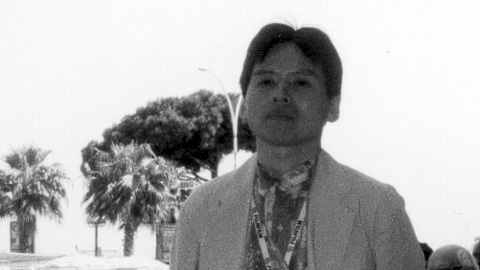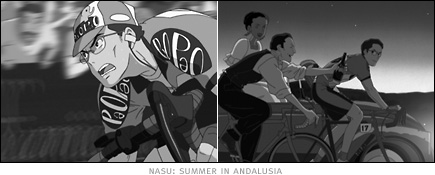Kitaro Kosaka
- Published
- 6 October 2003

by Tom Mes
After several decades working with the biggest names in Japanese animation on some of the most important films in recent years (Katsuhiro Otomo's Akira, Rintaro's Metropolis, Hayao Miyazaki's Nausicäa and the majority of Studio Ghibli's output to name but a selection), Kitaro Kosaka made his own directorial debut with Nasu: Summer in Andalusia. An adaptation of the manga by Iou Kuroda, about a young cyclist attempting to win a bike race in his hometown, the impressive 47-minute film became the first Japanese animation selected for the Cannes Film Festival, establishing Kosaka as one of the country's most promising animation talents.
You've said that Nasu is about something that is missing from Japanese society, that the
determination of the main character Pepe is something the Japanese generally lack.
I felt that the bicycle race was a fitting symbol for life. We move through the course of it in groups and compared to other sports there are few rules; what rules there are, are mainly based on the understanding between the participants. In races, if you have no ambition you can just follow the others in your group and make it to the finish line without effort. But if you do want to achieve something, then the more difficult your situation, the harder you need to struggle. I find it very admirable and beautiful if people show the strength to try and achieve something, regardless of whether they succeed or not. But this spirit is something that I feel is missing in the attitude of today's Japanese people.
I believe that attitude used to be part of the Japanese people. The samurai had such strong spirits, even if they lost and perhaps they died, they fought their battles with determination. In our society today, all we have eyes for is results. So if you lose, nobody notices your determination. In that process, as a result of a loss of self-confidence many people lose the spirit of determination.
The character of Pepe is also very much in touch with tradition, isn't he? He wants to win because he's riding in his hometown, which is something he is very proud of. The eggplant, the nasu of the title, seems like the symbol for that connection with tradition, particularly when Pepe shows his racing buddies how it's prepared and eaten.
Pepe is not a superman, he's not a perfect human being, but a regular guy. The nasu is not a main plate, but a snack, a side dish. In Japan we even have insults with the word 'nasu': 'bokenasu' and 'otankonasu' [literally: 'stupid eggplant']. So by using the symbol of the eggplant I wanted to show how even a normal person can achieve something.
I understand that you yourself are a cycling enthusiast. Is that the reason why you decided to adapt this particular manga?
In Japan this sport is rather unpopular, so it's quite difficult to come into contact with. I was quite intrigued by it and started following some races, which really got me hooked and I began taking part. I understood that there was a philosophy, an essence, to it. There was more to it than just the enjoyment of taking part in a sport. It's because I had this understanding that I knew I could adapt this manga into a film.
Perhaps the fact that this sport is not so popular in Japan already proves the point you were trying to make with the film.
Yes, I guess that's true. Although recently the popularity of cycling has been slowly increasing. Maybe people realise that cyclists have this spirit that most of us have forgotten today. In a bicycle race, if you win by cheating, you're not admired. Nobody respects you if you follow the others until just before the finish line and then steal the victory by suddenly sprinting away. I think that's interesting and perhaps others are beginning to see it too. Maybe this is a reason why the interest in the sport has increased lately.
Maybe the film will help promote the sport too.
I really hope so. Most of all I hope that people will notice the story is a metaphor for life and that the film will encourage them. Even if you're not sure that you are strong enough to achieve your goals, you should still try.

The film is set in Andalusia, Spain. Did you do a lot of research into the area? Did you go there yourself?
Yes, I read a lot of documentation and went there myself for one week. Although we modified it slightly, I travelled along the same route we use in the film as well as the surrounding areas.
Was it important for you to stay close to the reality of the area?
Actually, I was surprised by how green the landscape was. There were more trees and vegetation than I had expected. I decided to make the image of the area slightly more spacious in the film, because it would allow the viewer to focus on the action without being distracted by the landscape too much. I wanted to remain true to reality of course, but above all I wanted to focus on the characters, so this is the only sacrifice we made with regards to capturing reality. Actually, the area between Malaga and Cordoba is drier, more like the landscape in the film.
Is sticking close to reality something you generally like to do in your work?
It's not a rule I will stick to rigidly, but generally I like my films to be realistic. I want to take care to stay true to reality, above all to capture the essence of everyday life. It's easier for the audience to understand and sympathise in that case. Using abstract images, which is easier in animation because it's further removed from reality than live action cinema, makes the film more difficult to engage with and therefore less interesting.
Computer graphics are used very much as a tool in your film. It works very well here, with the changing perspectives of the background and the buildings.
That's very true. The background is very important, because those backgrounds that pass by really fast do a lot to emphasise the dramatic aspect of the film. Without computer graphics it wouldn't be possible to make this film.
There are a lot of overhead shots and I can imagine doing those on computer makes them a lot easier to do. Did the use of computer graphics influence the choice of shots?
Yes, they did.

In the final sprint, you switch to a very sketchy drawing style, which comes directly from the manga. Why did you decide to stick to that style, which is quite unusual for animation?
Firstly, it was important to make the final sprint very impressive. Also, when I read the manga, I was very impressed by that style, so I thought it would by nice to try and remain faithful to it in the film.
There's something about that deformed, rough style that reminds me of Sogo Ishii's early films.
(laughs) I never thought to make that connection myself. I feel now that I could have restrained the use of that style a little bit more. If you use it too much it gets tired on the audience's eyes.
Was it your idea to ask Kiyoshiro Imawano to sing the theme song?
The lyrics to this song are a kind of in-joke, they're very much related to the sport of cycling. If you don't know anything about the sport, you won't get the joke, so it's a kind of gift to cycling fans. It's a well-known fact that Kiyoshiro is a cycling enthusiast himself, that's why I asked him. His songs are always quite particular. His lyrics are really funny. They're not really jokes, but he plays around a lot with combinations of words and their meanings. He also uses uncommon words that have a very particular meaning. When your brain is too much caught up in thought and you hear one of his songs, you immediately snap out of it and become more relaxed. Kiyoshiro came to the sound studio every day on his bicycle, and to the wrap party as well. In his maillot jaune. (laughs)
What kind of director are you? Do you draw frames yourself or do you delegate more?
I'm involved in a hands-on way in the writing and the concept development. I delegate aspects like backgrounds and CGI to those departments. For the character animation I keep a close eye on continuity and likenesses.
The last few years you've been quite closely connected with Studio Ghibli. So how did this project end up being made at Madhouse studios?
Actually it was Mr. Miyazaki, who is also a fan of cycling, who introduced me to the manga Nasu, because he knew we share an interest in the sport. I suggested to adapt it together, but he said "I'm too old now, I don't have enough energy." So I took the idea to Mr. Masao Maruyama of Madhouse, whom I'd known for a long time, and he accepted my idea to make the film.
You've worked at many different animation studios in the past, including Ghibli and Madhouse. Were you ever an employee at any of these or were you a freelance artist?
It depended on the project. For the duration of a project I was an employee under contract to that particular studio.
How did you get your start in animation originally?
I enjoyed drawing and I was a big fan of Hayao Miyazaki, so my wish was to work for him. This was before he formed Studio Ghibli. He was working at Telekom at the time, and that studio was looking for new animators. I applied, but I was turned down in the first round of selection. I entered a small production company that sometimes worked for Miyazaki called Oh! Productions, and later became freelance.
Japanese animation has long appealed to a cult audience in the West. The Golden Bear and the Oscar for Spirited Away and your film being the first Japanese animation selected for Cannes seem to indicate that it has finally reached broader audiences.
That might be true, I hope so at any rate. I don't think it's such a sudden phenomenon, though. Japanese animation reached a fairly young foreign audience in the West many years ago. What we're seeing today is the result of those fans growing up. Some of those young fans of Japanese animation are now members of festival committees or juries. In a way it's a logical process. So my being in Cannes was not the result of my talent, it's built on the achievements of animators in the past.